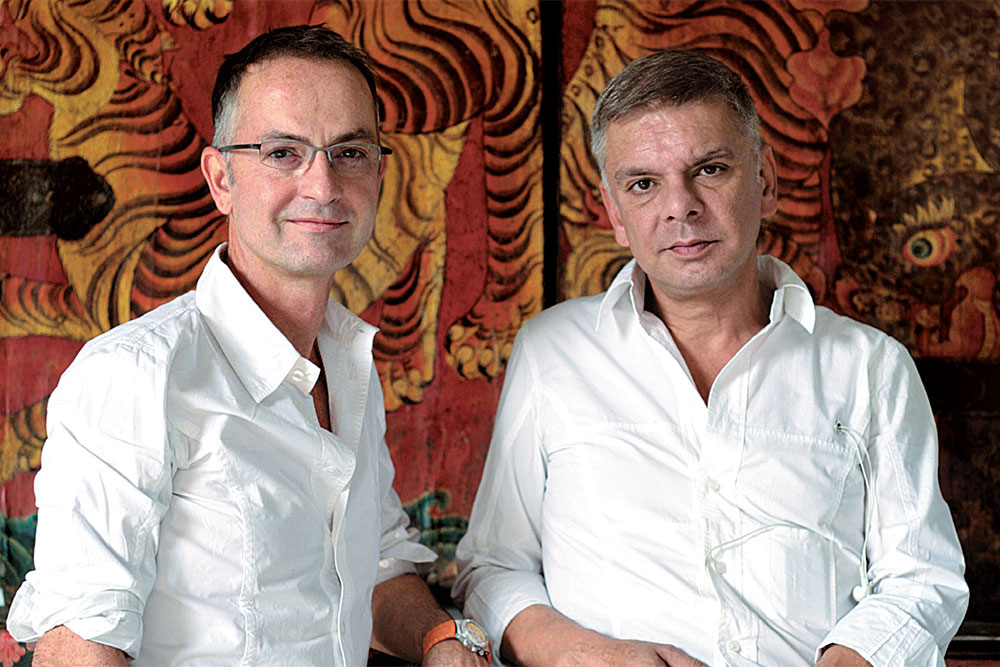They met in fashion school in France, and made fashion history. What can factually be called the only Asian, read Indian (Hemant Sagar has an Indian father and a German mother) design brand to ever successfully create couture dresses for the Parisian hoi polloi, it’s been some journey. Now, 15 years after their return to India, with a new ready-to-wear label for the ‘international Indian’, they are scoring a triumphant victory in prêt fashion, with the ambition and wherewithal to achieve the scale and reach that few India-based companies can attempt.
The story began in Paris, in the year 1979. Hemant Sagar paired up with fellow student, Frenchman Didier Lecoanet to create what was to be their first made-to-measure dresses. “We were green and discovering things,” says Hemant Sagar. “By 1980 we had found a shop in Faubourg St Honoré, and by the next year we had the shop and the collection.” That February, their collection was a sellout. By the time their second collection rolled around, Hemant and Didier had set up their own workshop, the baby steps leading to their very own haute couture atelier. After formally gaining entry into the prestigious Chambre Syndicale de la Haute Couture, by 1984, they were showing haute couture officially. “At that time we had the suffix, ‘Styliste, Modéliste’, that we dropped later,” says Hemant.
Hemant describes his atelier in the 8th arrondissement in a small street next to a Michelin-starred restaurant called Le Taillevent, with around 30 people working for them, and shows held every six months at the Hotel Intercontinental, in beautiful halls. “It was a classic little place,” says Hemant.
They stayed until 1990. Their customers included members of the French aristocracy, Princess Helène of Yugoslavia, Princess Victoire de Bourbon-Parme, singer Patricia Kaas, actor Melanie Griffith. “There were no Indian clients then, as there are none today,” says Hemant. Arab royals came in to buy 15 dresses “each costing as much as a car”. Their silhouettes were vaguely inspired by India, by their own admission. “We had drapes, and we got known for our own way of draping,” says Hemant, as the only Asians besides the Japanese designer Hanae Mori. “Till today, in a span from 1855 to 2015, we are the only Indian background company in haute couture.
But things were changing. Ready-to-wear was taking over, and clients didn’t want to go through the hassle of returning to Paris five times for fittings. “I had American clients who would say, ‘Do you realise that we have to take the Concorde three times for this dress?’”, laughs Hemant.
“There were 24 couture houses when we started, and when we left there were about seven or eight.” They were famous for their bustier dresses – “The real couture dress is a sculpture, it stands by itself,” says Hemant. Their seamstresses would interpret the designers’ lines and come up with a toile, or a cheesecloth, and make a first raw piece to try on a dummy replicating the client’s body.
The entire process was getting démodé, and business by the time they reached their 30s and 40s, was declining to the point where there was no future in haute couture, except for the big names like Saint Laurent, Dior, Chanel, and smaller ateliers like Ungaro, Jean-Louis Scherrer, and Nina Ricci. “We were the really small ones, like Louis Féraud, and we were ready to move,” says Hemant. But with the boom in China, the future beckoned in India, and so they returned in 2000.
Today, the Gurgaon-based designers with their state-of-the-art yet very artistic 100,000 sq ft headquarters are set to conquer the premium ready-to-wear market. Having already established a strong presence in the country with their eponymous label Lecoanet-Hemant, they plan to attract a more youthful, more modern Indian with their new label Genes.
“Genes was prepared three years ago, and we wanted the democracy,” says Hemant. “Instead of working for one client, we wanted to work for 10,000. We understood haute couture was dead and impossible to reproduce in India, so we built on our past as the Indians in Paris, and the Frenchies in India.” Genes is priced between ₹2,500 to ₹25,000 and aims to be more aspirational.
A walk to their factory reveals gigantic office spaces (at 1,000 sq ft each) for both Hemant and Didier, who is the creative head. Built by architect Arun Rewal, it took four years to complete and has leather, jewellery, and embroidery departments, with over 200 machines, plus cutting tools. The factory is air-conditioned and air-cooled for the comfort of the workers, and they pride themselves on reaching out to the 450 workers there and speaking to them one on one. “The thought is Indian but the spirit is Western,” says Hemant of their concept. Their capacity is enormous: in two months, they can churn out 22,500 garments, and have been producing Pierre Balmain’s full runway collection for the past five years.
“We see ourselves as the Ralph Lauren of India, but edgier,” says Hemant of his plan to become a big lifestyle brand encompassing perfume, and maybe even furnishings. Right now, they are focused on Genes, available exclusively on their website, genestribe or through Amazon which will follow a two-year cycle. “It’s only two weeks old, and right now the most expensive pieces are the biggest sellers.” A couturier’s dream, this, on a large scale.












 Just one email a week
Just one email a week